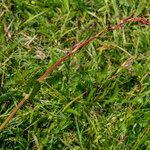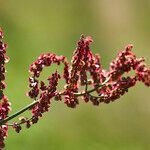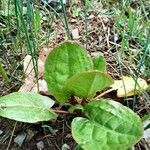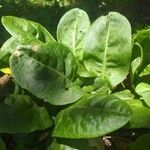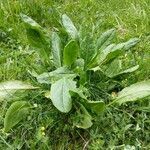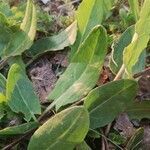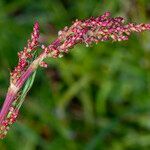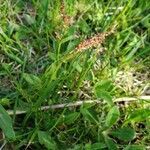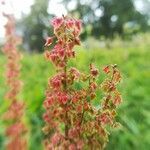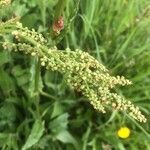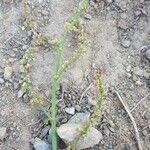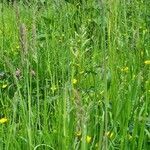Herbs perennial, dioecious, with a short and relatively thin horizontal or slightly oblique rootstock, usually not reaching deep into substrate and with rather crowded secondary roots. Stems erect, 40-100 cm tall, grooved, glabrous, usually simple. Basal leaves ovate-lanceolate to lanceolate, base sagittate, 3-12 × 2-4 cm, margin entire, apex acute, basal lobes acute at apices; cauline leaves small; petiole short or nearly absent; ocrea fugacious, white, membranous. Inflorescence terminal, paniculate, lax; branches reddish green, slender, simple or with a few secondary branches. Flowers unisexual. Pedicel slender, articulate at middle. Male flowers: outer tepals erect, small; inner tepals elliptic, ca. 3 mm. Female flowers: outer tepals elliptic, reflexed in fruit; inner tepals enlarged in fruit; valves nearly orbicular (to broadly ovate), 3.5-4 mm in diam., with small recurved tubercles at base of valves, net veined, base cordate, margin entire, apex obtuse. Achenes blackish brown, shiny, ellipsoid, trigonous, ca. 2 mm. Fl. May-Jul, fr. Jun-Aug. 2n = 14*, 15*, 22*.
Dioecious perennial 3–10 dm, the stems 1–few from a stout root, usually simple to the infl; lvs oblong, all or chiefly sagittate, the lower long-petioled, the upper subsessile; infl 1–2 dm, usually lfless, open, the branches mostly simple; pedicel jointed at about midlength; tep of staminate fls 2–3 mm, the outer oblong, the inner obovate; outer tep of pistillate fls triangular-ovate, nearly 2 mm, soon reflexed; valves thin, broadly round-cordate, 4–6 mm long and wide, reticulate-veiny, the midrib of at least one of them dilated at the base into an evident grain or tubercle; achene dark brown, 2–2.5 mm; 2n=14 (&), 15 (%). Native of Eurasia, in our range an occasional weed from Conn. and Pa. northward.The closely related Eurasian sp. R. thyrsiflorus Fingerh., with a denser infl, the primary branches again branched, and with the lf-lobes often a little more divergent, has been reported in n. Mich. and on the s. side of the St. Lawrence R. in Que.
Slightly puberulent, dioecious perennial; rootstock ± woody; stems to c. 1 m tall, reddish towards base. Lower lvs with long slender petioles several times > lamina; uppermost lvs shortly petiolate or subsessile, somewhat amplexicaul. Lamina 3.5-12 × 1-3 cm, narrowly oblong to ± lanceolate, pleasantly sour to taste, entire except for 2, ± downwards-directed, basal lobes to c. 1.3 cm long; apex obtuse. Infl. to c. 30 cm long, reddish, with several simple branches, leafless. Fls in fascicles; pedicels slender. Perianth of ♂ fls 1.5-2 mm long. Outer perianth of ♀ fls c. 0.5 mm long, soon strongly reflexed; valves orbicular-cordate, winged, entire and lacking tubercles, enlarging to 2.8-3.5-(4) mm at fruiting, ± rose-red. Nut c. 2-(2.3) mm long, dark shining brown, acutely angled.
A small plant. It keeps growing from year to year. It grows 50-100 cm high and spreads 30-40 cm wide. It forms clumps. The leaves are broad and spear-shaped. The veins run from the midrib to the edge of the leaf. The ears at the base of the leaf are smaller. The leaves are 15 cm long. The flowers are small and red on long stalks. There are some named cultivated varieties.
